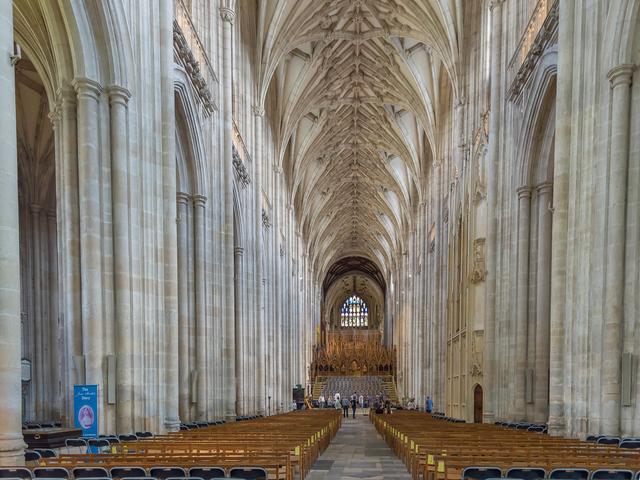Myths about teaching can hold you back
- Year 7
Norman reforms to the English Church
I can explain how the Normans changed the English Church and how historians can use buildings as material evidence.
- Year 7
Norman reforms to the English Church
I can explain how the Normans changed the English Church and how historians can use buildings as material evidence.
These resources were made for remote use during the pandemic, not classroom teaching.
Switch to our new teaching resources now - designed by teachers and leading subject experts, and tested in classrooms.
Lesson details
Key learning points
- The Pope wanted the Anglo-Saxon Church to be reformed.
- The Norman government replaced the leadership of the Anglo-Saxon Church.
- Lanfranc became Archbishop of Canterbury and conducted a programme of reform.
- Historians sometimes use material remains as sources.
- Winchester Cathedral represents an important source for the study of the Anglo-Norman Church.
Keywords
Church - the organisation of the Christian religion
Cathedral - the principal church of a diocese and the seat of a bishop
Monk - a person who has withdrawn from normal life to dedicate their life to God
Monastery - a place where monks live
Priest - a person who works for the Church and helps people with religious matters in the local community
Common misconception
Students might think that 'the Church' is a physical building in which people pray.
Explain that 'the Church' refers to the wider organisation of the Christian faith, including all buildings and people which belong to it.
To help you plan your year 7 history lesson on: Norman reforms to the English Church, download all teaching resources for free and adapt to suit your pupils' needs...
To help you plan your year 7 history lesson on: Norman reforms to the English Church, download all teaching resources for free and adapt to suit your pupils' needs.
The starter quiz will activate and check your pupils' prior knowledge, with versions available both with and without answers in PDF format.
We use learning cycles to break down learning into key concepts or ideas linked to the learning outcome. Each learning cycle features explanations with checks for understanding and practice tasks with feedback. All of this is found in our slide decks, ready for you to download and edit. The practice tasks are also available as printable worksheets and some lessons have additional materials with extra material you might need for teaching the lesson.
The assessment exit quiz will test your pupils' understanding of the key learning points.
Our video is a tool for planning, showing how other teachers might teach the lesson, offering helpful tips, modelled explanations and inspiration for your own delivery in the classroom. Plus, you can set it as homework or revision for pupils and keep their learning on track by sharing an online pupil version of this lesson.
Explore more key stage 3 history lessons from the The Norman Conquest: how do we know about the impact of the Conquest on England? unit, dive into the full secondary history curriculum, or learn more about lesson planning.

Content guidance
- Depiction or discussion of sensitive content
- Depiction or discussion of serious crime
- Depiction or discussion of violence or suffering
Supervision
Adult supervision required
Licence
Prior knowledge starter quiz
6 Questions
Q1.Match these people with the correct descriptions.
Norman conqueror, crowned king of England in December 1066
Norman chronicler, who wrote about William's conquest
Norman bishop, half-brother of William
William's wife, she governed Normandy when William was away
Q2.Match these words connected to religion with the correct definitions.
place of worship for Christians
works with the community and performs rituals in church
the most important church in its area (called a diocese)
religious leader in charge of a diocese
an area under the control of a bishop
the bishop of Rome and leader of the Catholic Church
Q3.Normandy was a duchy in the north of which modern-day European country?
Q4.Which one of these is not a way in which the Gesta Guillelmi seeks to justify or strengthen William’s claim to the throne?
Q5.Which of the following best explains why historians think carefully about the claims reported in the Gesta Guillelmi?
Q6.Monks in Norman England followed strict rules. Which one of these were Norman monks not allowed to do?
Assessment exit quiz
6 Questions
Q1.Match the words with the correct definitions.
the principal church of a diocese and seat of a bishop
works for the Church to help people in the local community
a man who withdraws from normal life to focus on God
a place where monks live
the organisation of the Christian religion
Q2.In 1070 William the Conqueror appointed a new Archbishop of Canterbury. What was the Archbishop’s name?
Q3.The Normans and the Pope disapproved of the way the Anglo-Saxon Church operated. Which of these common Anglo-Saxon practices were Normans critical of?
Q4.Which of these were things that Lanfranc carried out in his reform of the English Church?
Q5.The Normans replaced Anglo-Saxon churches and cathedrals with buildings in a style known as .



